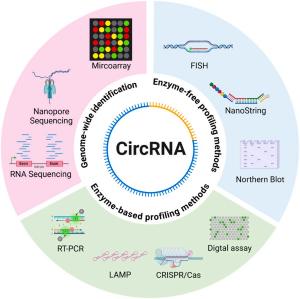Advances in the Molecular Diagnostic Methods for Circular RNA
GA, UNITED STATES, December 5, 2024 /EINPresswire.com/ -- The author summarized the traditional and emerging methods for circRNA detection as well as the advantages and limitations, and look forward to future research directions.
Circular RNA (circRNA) is a unique type of non-coding RNA produced by back splicing of mRNA to form the covalent junction without 3’-5’ polarity and poly(A) tail. CircRNA was first discovered about 30 years ago and was considered a byproduct of abnormal splicing without regulatory function. In 2013, it is the regulatory mechanism of circRNA as miRNA sponge was reported, opening up a new avenue for circRNA research.
With the development of detection technologies, a large number of circRNAs have been identified in organisms, and their biological functions and mechanisms have been uncovered gradually. In particular, circRNAs are abnormally expressed and play a critical role in many diseases, including gastric cancer, hepatocellular carcinoma and breast cancer.
In a study (doi: https://doi.org/10.1016/j.bioana.2024.11.002) published in the KeAi journal Biomedical Analysis, a group of researchers from China reviewed the advancements for specific and sensitive detection of circRNAs. They described the principles of these technologies, discussed the advantages and limitations of these methods and highlight the breakthroughs of isothermal amplification, CRISPR and digital droplets assay.
"CircRNAs have emerged as promising biomarker for cancer because its expression levels in tumors and normal tissues are vary greatly,” explains corresponding author Jiasi Wang, a professor at the Sun Yat-sen University. “An increasing number of studies suggest circRNAs are involved in the proliferation, invasion and metastasis of tumor cells.”
In view of this, circDNAs can be used as a potential ideal biomarker for cancer diagnosis and prognosis, offering advantages over existing RNA biomarkers, such as superior stability, preservation and tissue-specific expression.
“The sensitive and specific detection of circRNA is important for the understanding the biological function of circRNA and tracking the disease process, as well as the prerequisite for clinical application,” adds Wang.
The most common methods being used to detect circRNA are RNA sequencing and RT-PCR. “RNA sequencing can reveal the actual structure and discover new circRNA, but it is inefficient and hence tends to miss low-abundance circRNA,” shares Wang. “It is also expensive and complicated to perform.”
The team highlighted that while RT-PCR is the gold standard for circRNA validation,it can overestimate expression due to the peculiar structure of circRNA.
"Though the field of circRNA has made great progress in the past 10 years, it is still challenging to precisely detection and quantification of circRNA, especially in intracellular environment, due to the circular conformation and sequence overlap with their cognate mRNAs,” says Zequan Ye, first author of the study.
DOI
10.1016/j.bioana.2024.11.002
Original Source URL
https://doi.org/10.1016/j.bioana.2024.11.002
Funding information
This study was supported by the National Key Research and Development Program of China (2023YFC2307305), the Shenzhen Medical Research Fund (B2303003), Shenzhen Research Funding Program (JCYJ20220818102014028; RCBS20210609104339043), National Natural Science Foundation of China (No. 22174167), the Guangdong Basic and Applied Basic Research (Grant No.2024A1515011281), and Fundamental Research Funds for the Central Universities (Project No.: 24qnpy087) from Sun Yat-sen University .
Lucy Wang
BioDesign Research
email us here
Legal Disclaimer:
EIN Presswire provides this news content "as is" without warranty of any kind. We do not accept any responsibility or liability for the accuracy, content, images, videos, licenses, completeness, legality, or reliability of the information contained in this article. If you have any complaints or copyright issues related to this article, kindly contact the author above.

